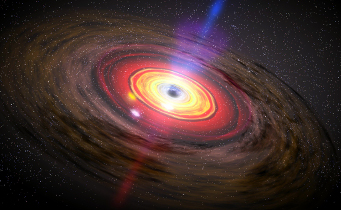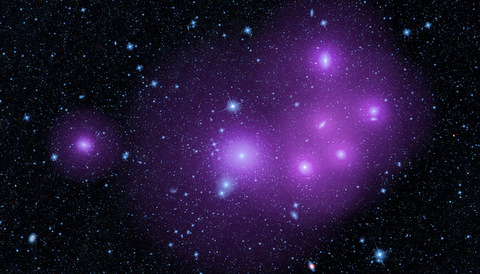Galaxies’ central black holes are surprisingly simple creatures at heart, but they have a complicated past. New studies are starting to remove history’s obfuscating veil.

NASA / Dana Berry (SkyWorks Digital)
Simple — not exactly the first word that comes to mind when you think of black holes, is it? Especially not the glowing, supermassive variety that make their nests in galaxy centers. These beasts gorge on gas that shines at every wavelength, and they display so much variety (“radio-loud” and “X-ray quiet” are just two of the many terms astronomers apply), they could fill a zoo.
Yet these creatures, called active galactic nuclei (AGN), are simple. Each one has the same basic elements: a black hole with the mass of millions or billions of Suns, a gas accretion disk that feeds the black hole, and sometimes a jet that comes spitting out from near the black hole’s poles.
So how does one simple creature fill a zoo? For decades, astronomers explained the variety by adding another element to AGN structure: a donut-shaped cloud of dust and gas that wreaths the inner parts. Depending on the viewing angle, the donut hides the AGN, so the appearance of an object depends purely on its orientation to our line of sight.
But the donut has by no means explained everything; evidence that the donut even exists has been ambiguous. Now two new studies add to a growing body of evidence that says, whatever the role of the donut, the key to understanding AGN zoology lies in revealing their past.
Getting to Know the Neighbors

NASA / JPL-Caltech
Recently, a team led by Emilio Donoso (Instituto de Ciencias Astronómicas, de la Tierra, y del Espacio, Argentina) picked out about 170,000 AGN out of 563 million infrared sources cataloged by the Wide-field Infrared Survey Explorer (WISE). The spacecraft had surveyed the entire sky multiple times over a period of 10 months, measuring brightnesses at a variety of infrared wavelengths.
Because WISE observed infrared radiation, it was able to peer through gas and dust to find every type of AGN, including those that a donut would have hidden at other wavelengths. The team distinguished between hidden and exposed AGN by comparing their infrared brightness with the visible-light brightness cataloged in the Sloan Digital Sky Survey.
If orientation were the only thing that mattered, then AGN should scatter randomly across the sky no matter what type they are. Instead, Donoso’s team found that obscured AGN tend to cluster closer together.
This result, to be published in the Astrophysical Journal, comes at the same time as another study published recently in Nature Physics. Beatriz Villaroel and Andreas Korn (Uppsala University, Sweden) plumbed the depths of the Sloan Digital Sky Survey to pick out 72,262 relatively nearby AGN whose host galaxies had been classified through the citizen-science power of Galaxy Zoo. They looked not so much at the AGN themselves, but at their neighbors, finding that hidden AGN tend to live closer to gas-rich, star-forming galaxies.
Black Holes with a Past
Both studies support the same general picture of AGN evolution. When two galaxies merge, gas plunges toward the central black holes, feeding them while also obscuring them from view. Eventually, a jet or wind blows out and pushes away the surrounding gas, exposing the still-feeding black hole.
In other words, hidden AGN are not necessarily exposed AGN viewed through a dusty donut; they are the precursors, evolving into exposed AGN over time.
Both studies are part of “a movement that’s gaining steam toward a more realistic formulation of AGN structure,” says Moshe Elitzur (University of Kentucky). “It would be ridiculous to think that AGN never evolve and that they are all exactly the same.”
But as usual, the devil is in the details. Do AGN evolve in tandem with their galaxies, or do they lag behind? How does the torus, if it exists, change over time? These studies can’t yet answer those questions and until they do, the AGN zoo will remain just that: a zoo.
References:
Emilio Donoso et al. “The Angular Clustering of WISE-Selected AGN: Different Haloes for Obscured and Unobscured AGN,” to be published in the Astrophysical Journal.
Beatriz Villarroel & Andreas J. Korn. “The Different Neighbors Around Type-1 and Type-2 Active Galactic Nuclei,” Nature Physics, 11 May 2014.
 0
0









Comments
You must be logged in to post a comment.